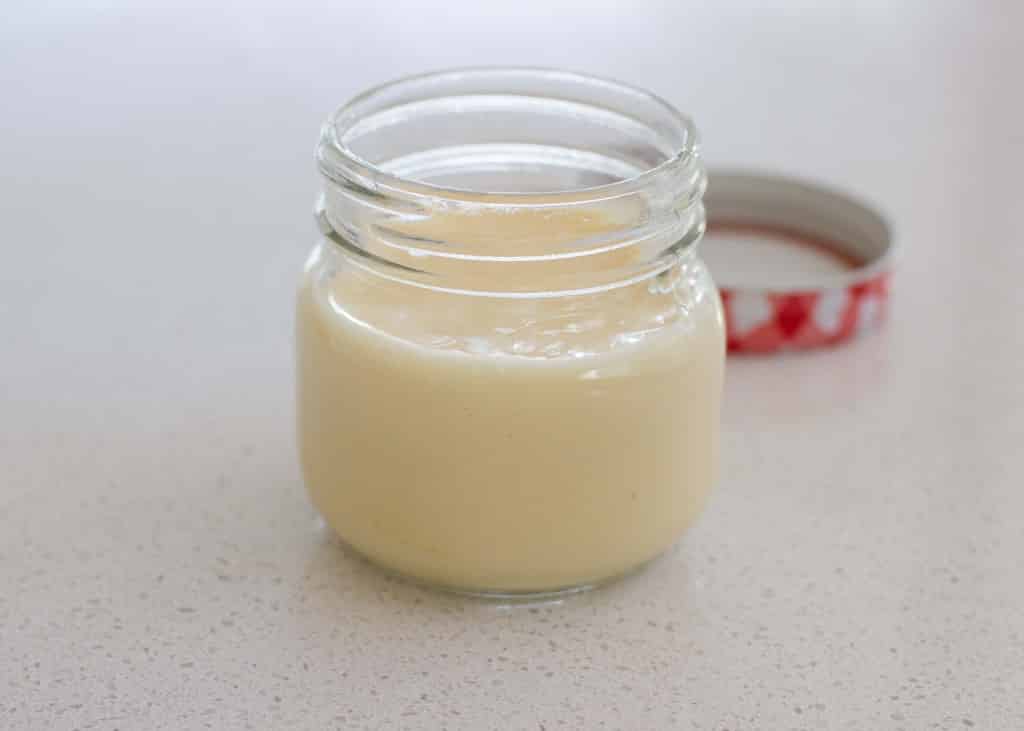- Light mayo: Any food labelled as “light” carries one-third fewer calories than the regular version. Per 1 tablespoon, mayo contains 45 calories, 4.5 grams fat, and 0.5 grams saturated fat.
- Reduced fat mayo: Any food named as “reduced fat” includes limited or 25 percent cholesterol and 2g of saturated fat or less than the full-fat version. This mayo includes 25 calories, 2 grams fat, and no saturated fat per tablespoon.
- Alternate oil-based mayonnaise: Olive oil and Canola mayonnaise are prepared as “healthier” options. Both are powerful in heart-healthy monounsaturated fats, but the calories are the same. Additionally, olive oil mayos direct to blend olive oil with other vegetable oils so that the flavor isn’t too overwhelming.
- Canola oil mayo: 11 grams fat, 100 calories, 0.5 grams saturated fat
- Olive oil mayo: 11 grams fat, 100 calories, 1.5 grams saturated fat
- Decreased fat olive oil mayo: 4 grams fat, 45 calories, 0 grams saturated fat.
- Vegan mayonnaise: Some vegan variations add a canola-oil based eggless mayo by Spectrum Organics. Extra is soy-based mayonnaise by Nasoya, made outwardly with eggs and a mixture of spices. They’re both proper for folks who attend a vegan diet or are allergic to eggs.
- Light canola eggless mayo: 3.5 grams fat, 35 calories, 0 grams saturated fat
- Nayonaise: 3.5 grams fat, 35 calories, 0.5 grams saturated fat
 In terms of quality, taste, and nutrition Homemade mayonnaise will always be superior. For one, they get to select healthier edible oils.
For another, they get to keep away food preservatives and chemical additives that are typically there in commercially produced versions. Furthermore, making one’s own mayonnaise guarantees fresh condiment every time.
In terms of quality, taste, and nutrition Homemade mayonnaise will always be superior. For one, they get to select healthier edible oils.
For another, they get to keep away food preservatives and chemical additives that are typically there in commercially produced versions. Furthermore, making one’s own mayonnaise guarantees fresh condiment every time.
- One can choose any type of oil to use, though olive oil is by far the most popular in home recipes. One can experiment with macadamia nut oil as per their wish.
- It would be best if one can source free range eggs as well wherein a glass bowl, two egg yolks can be whisked using a hand blender.
- One can slowly add three-fourths to a cup of their choice of edible oil while constantly whisking till the mixture solidifies. Season with freshly pressed lemon juice, salt, and fresh ground black pepper and mix until thoroughly thick.
- Store it in a sealed glass jar and position in the refrigerator. This homemade mayonnaise should last for a week.
 Mayonnaise is a healthy rich sauce used for a variety of purposes. It is generally used as a spread to create a base. This base is applied to pizza, sandwich and so on. It is in other way used for dressing salad, pasta and as a dip for French fries and seafood.
Mayonnaise is prepared with egg yolk in a few simple steps. One can prepare this sauce at home and can preserve it for several months.
First of all the egg’s yolk is whipped well and then a few drops of olive oil and lemon juice are combined with it. Vinegar can be used more instead of lemon juice. Another method comprises the usage of flour, milk butter, and vinegar or lemon juice.
This recipe is usually followed by vegetarians who are not averse to eggs.
Pros And Cons Of Mayonnaise
Mayonnaise is a healthy rich sauce used for a variety of purposes. It is generally used as a spread to create a base. This base is applied to pizza, sandwich and so on. It is in other way used for dressing salad, pasta and as a dip for French fries and seafood.
Mayonnaise is prepared with egg yolk in a few simple steps. One can prepare this sauce at home and can preserve it for several months.
First of all the egg’s yolk is whipped well and then a few drops of olive oil and lemon juice are combined with it. Vinegar can be used more instead of lemon juice. Another method comprises the usage of flour, milk butter, and vinegar or lemon juice.
This recipe is usually followed by vegetarians who are not averse to eggs.
Pros And Cons Of Mayonnaise
 Mayonnaise, as a base, can be utilized with many sauces. As an example, a mixture of mayonnaise, tomato sauce, and mustard sauce results into the condiment. When blended with tomato ketchup it makes fry sauce – a new kind of yummy sauce.
Tartar sauce can be done with the mayonnaise, parsley, and carper which tastes great with seafood. Try other dips with the combination of green onion, ground pepper, pickle relish, and other ingredients to make something delectable out of it.
Any number of recipes can be made out of the combination of mayonnaise and other ingredients, which tastes good with a chicken wing, bread loaves, salads, fish and other kinds of seafood. One can also skim these easy recipes online to attempt something new and tasty!
The unhealthiness of mayonnaise is simply a misconception. People usually think so but research has proven it wrong. Mayonnaise actually has multiple health benefits. Mayonnaise sauce contains the rich omega-3 fatty acids and vitamin E, that are good for human health.
Healthy Heart: Mayonnaise is a vital source of vitamin E that can prevent strokes. It also has Omega-3 acid, which is good for the heart. Advantages of Mayonnaise on postmenopausal women have also been confirmed.
Lungs: Lungs are the most prominent organ of the human body that removes C02 from blood and keeps one healthy. Mayonnaise helps in proper functioning of the lungs as well. It plays an important role in keeping the lung healthy and vibrant.
Baby Soft Skin: Mayonnaise can also be directly applied on the face to get baby soft and radiant skin. It holds the skin and helps in looking fresh and glowing.
Hair: Mayonnaise is thought of as the best treatment for dull and frizzy hair. It works as a conditioner; it smoothed hair and leaves hair silky and softer. Take a dwarf amount of mayonnaise and spread it from the root to tip of the hair. Move it for an hour and rinse off the hair to get a shiny look. It can further be used as a treatment for lice.
Sunburn and chapped skin: Mayonnaise is well used to treat sunburn if it is applied to the affected area for getting the soothing effect. Another sound benefit of mayonnaise is the quiet removal of dead cell or skin.
Apply it on the elbow, feet chapped lips and on the flaky skin in order to nourish the affected area and make thy skin softer.
However, an excessive amount of calories in mayonnaise may lead to weight gain. Therefore, use it in a limited amount while enjoying its taste and benefits.
There are substantial numbers of sauce suppliers that manufacture and supply many varieties of sauce at a wholesale price.
Mayonnaise’s Risks
Mayonnaise, as a base, can be utilized with many sauces. As an example, a mixture of mayonnaise, tomato sauce, and mustard sauce results into the condiment. When blended with tomato ketchup it makes fry sauce – a new kind of yummy sauce.
Tartar sauce can be done with the mayonnaise, parsley, and carper which tastes great with seafood. Try other dips with the combination of green onion, ground pepper, pickle relish, and other ingredients to make something delectable out of it.
Any number of recipes can be made out of the combination of mayonnaise and other ingredients, which tastes good with a chicken wing, bread loaves, salads, fish and other kinds of seafood. One can also skim these easy recipes online to attempt something new and tasty!
The unhealthiness of mayonnaise is simply a misconception. People usually think so but research has proven it wrong. Mayonnaise actually has multiple health benefits. Mayonnaise sauce contains the rich omega-3 fatty acids and vitamin E, that are good for human health.
Healthy Heart: Mayonnaise is a vital source of vitamin E that can prevent strokes. It also has Omega-3 acid, which is good for the heart. Advantages of Mayonnaise on postmenopausal women have also been confirmed.
Lungs: Lungs are the most prominent organ of the human body that removes C02 from blood and keeps one healthy. Mayonnaise helps in proper functioning of the lungs as well. It plays an important role in keeping the lung healthy and vibrant.
Baby Soft Skin: Mayonnaise can also be directly applied on the face to get baby soft and radiant skin. It holds the skin and helps in looking fresh and glowing.
Hair: Mayonnaise is thought of as the best treatment for dull and frizzy hair. It works as a conditioner; it smoothed hair and leaves hair silky and softer. Take a dwarf amount of mayonnaise and spread it from the root to tip of the hair. Move it for an hour and rinse off the hair to get a shiny look. It can further be used as a treatment for lice.
Sunburn and chapped skin: Mayonnaise is well used to treat sunburn if it is applied to the affected area for getting the soothing effect. Another sound benefit of mayonnaise is the quiet removal of dead cell or skin.
Apply it on the elbow, feet chapped lips and on the flaky skin in order to nourish the affected area and make thy skin softer.
However, an excessive amount of calories in mayonnaise may lead to weight gain. Therefore, use it in a limited amount while enjoying its taste and benefits.
There are substantial numbers of sauce suppliers that manufacture and supply many varieties of sauce at a wholesale price.
Mayonnaise’s Risks
 Notorious for its high-fat content, Mayonnaise has about 70% to 80% of fat in it’s typical commercially produced versions of this condiment. Though the most common edible oil used is soybean oil as well that has been most likely extracted from genetically modified soybeans.
The regular mayonnaise is estimated as a calorically-dense food, with every tablespoon accommodating around 100 calories. Commercially designed versions of this condiment have considerably high sodium content as well with each tablespoon having as much as 80mg.
In reasonable terms, putting two tablespoons of mayonnaise into one’s usual turkey sandwich easily doubles its sodium, calorie, and fat contents.
Mayonnaise is undeniably one of the most preferred condiments out there. Its signature creamy yet slightly bitter taste makes it an exemplary base for fillings, sauces, and dips as well as a flavour enhancer for salads and sandwiches.
This is the reason almost every American kitchen won’t do without this sauce. Though this is the matter, moderate consumption of mayonnaise is still prescribed for a variety of occasions.
Notorious for its high-fat content, Mayonnaise has about 70% to 80% of fat in it’s typical commercially produced versions of this condiment. Though the most common edible oil used is soybean oil as well that has been most likely extracted from genetically modified soybeans.
The regular mayonnaise is estimated as a calorically-dense food, with every tablespoon accommodating around 100 calories. Commercially designed versions of this condiment have considerably high sodium content as well with each tablespoon having as much as 80mg.
In reasonable terms, putting two tablespoons of mayonnaise into one’s usual turkey sandwich easily doubles its sodium, calorie, and fat contents.
Mayonnaise is undeniably one of the most preferred condiments out there. Its signature creamy yet slightly bitter taste makes it an exemplary base for fillings, sauces, and dips as well as a flavour enhancer for salads and sandwiches.
This is the reason almost every American kitchen won’t do without this sauce. Though this is the matter, moderate consumption of mayonnaise is still prescribed for a variety of occasions.

